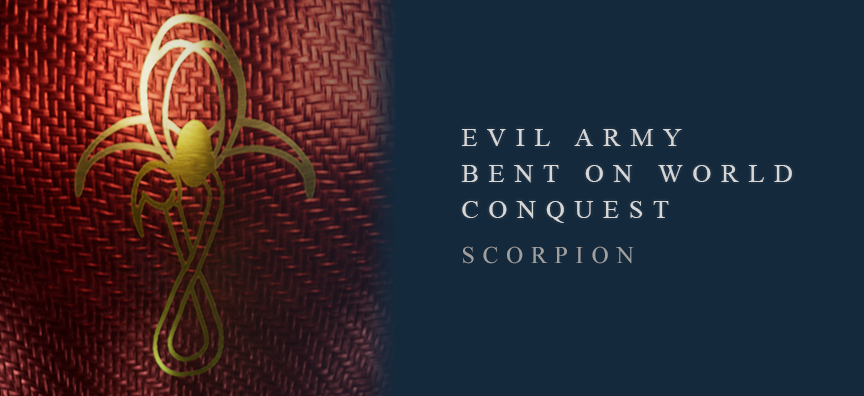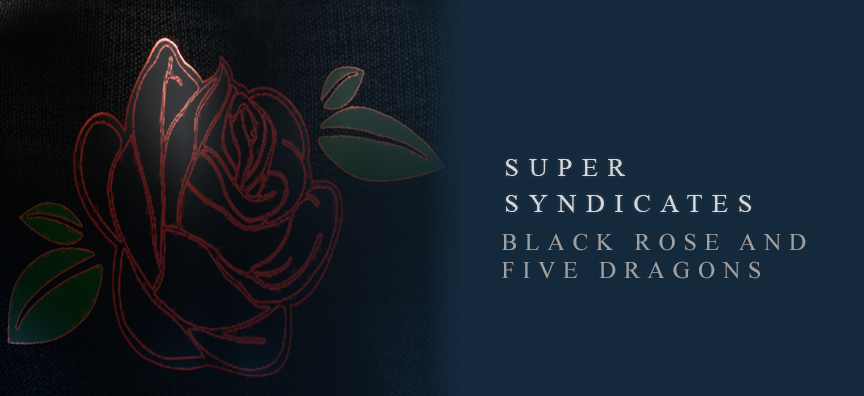Hello again, City of Titans fans. Today, I’d like to tell you about where we get our ideas for the game’s lore. It isn’t just a matter of taking some other game’s concepts and repackaging them. If anything, that is what we don’t do.
As I explained many Lore updates back, we’ve built Titan City around some of the classic tropes of the last eighty years of American superpowered adventure comics and their spinoffs in other media. Of course, we consider what will work well for use in a game—a different medium from comics, after all—along with a healthy dose of our own inspiration. We have lots of ideas, but some are just so characteristic of comic book stories that we had to use them. We’ve already told you about many of our ideas, but let me give you a look at the influences that went into some of them and made them must-includes.

If you’ve been following our updates, you’ve read about this world-conquering army and their colorful leaders more than once. Scorpion fills a critical niche. For decades, superheroes have battled villainous legions of mooks dressed in outlandish uniforms, hailing their fiendish masters as they enact those leaders’ bizarre schemes of world conquest. Without a group like this, who’s going to hold the city for ransom or give heroes the satisfaction of defeating hordes of faceless minions all at once?
Such a group also fills the critical need for an utterly, explicitly evil group for heroes to fight. Our lore is filled with complex twists and turns, and, as many fans have already realized, not every group’s public face matches its private goals. But sometimes, you just need the satisfaction of smacking around a villainous foe. That’s what Scorpion is there for (even though some aspects of the group developed into secrets that players will have to reveal anyway!).
Scorpion began very early in the lore’s development. We knew the kind of organization we needed, but we had to develop an iconic theme for the group—there had to be some visual motif to tie those armies of goons together, after all. Examples elsewhere in fantastic adventure fiction have been themed around everything from snakes to spiders to mythical monsters. After considering several possibilities, we settled on “Scorpion” for its iconic simplicity and the poisonous menace it implies. The fact that we had ideas for leaders named Serqet, inspired by the Egyptian scorpion goddess, and mad sorcerer-scientist Dr. Zubenelgenubi, named after a star in the constellation Scorpio, was also a factor. I refined an origin story for the group’s leader, incorporating my interest in ancient history and myth, invented a few other leaders based on other classic villain archetypes like the “honorable person in a bad organization” and “hero gone bad,” and soon, we were off and running.
We developed a backstory for the whole group, with a history stretching back to the early days of costumed heroes in the 1930’s and back even farther. The backstory gave us opportunities for links to ancient Egyptian, Greek, and Persian cultures, too, which further helped make the group distinctive. Incidentally, this is why you’ll see Scorpion leaders called “Archons” and “Satraps,” fire-wielding sorcerers called “magi,” and elite warriors called “Deathless” (a more literal translation of the name of the famed Achaemenid warriors, the Immortals).
From there on, Scorpion stories have often seemed to write themselves. A group like this cries out for wild plots to conquer the city or the world. For instance, in the 1930’s, in a nod to a classic pulp novel, Scorpion attempted to bring Titan City to its knees with a deadly substance that destroys structural steel, enabling it to hold entire buildings for ransom! You’ll get to see the consequences of that plot in the Hero North Path through the game, and there are plenty more appropriately fiendish plots in Scorpion’s works, too.

In a story about costumed heroes and villains (the player characters), crime naturally plays a big role. Nearly every superpowered adventure story features at least one far-reaching crime syndicate that controls vast resources, sends hardened killers after the protagonists, and is led by a reclusive, untouchable boss with a mysterious past and at least one peculiar affectation, such as constantly petting a white cat. Of course, City of Titans won’t launch with animal rigs available, so that particular schtick was out.
More seriously, we determined early on that we would launch with two major figures at the “top” of the underworld heap. This would help with variety in encounters and also provide scope for gang war stories, particularly for “street-level” PC heroes or PC villains interested in taking over criminal empires.
We decided very early on to use “classic mobsters” as one of these groups. The first writer to work on them combined this simple concept with another classic trope of the superpowered genre: strange technology that makes ordinary people superhuman. One of the most common kinds of superpowered hero story involves ordinary criminals who get their hands on fantastic gadgets, then use them to wreak havoc, after all. Thus, our mobsters became cybernetically enhanced, high-tech killers instead of merely stereotypical men in fedoras. Interestingly, the greatest struggle with this group was coming up with an appropriately evocative name. We knew they would use Italian phrases, but we had to try quite a few before we found one that sounded both refined and threatening in both Italian and English. For more about how la Rosa Nera, the Black Rose, got its name in-setting, go straight to the definitive source: its leader, the cagy old Father Omerta, explains it in an early episode of the Tales from the Underworld fiction series.
The second group was both easier and harder. Early on, everyone was calling out for an Asian-themed group, something along the lines of the yakuza. Because I knew that the rival mob would be technology-oriented, I decided to make this one magically aware. I chose to design them around Chinese alchemy and folklore, that being the kind of Asian folklore I knew best. It was quick and surprisingly simple to come up with different elementally themed minions. Its leader, the media-shy Lady White, practically wrote herself; this was a character I’d long wanted to use in fiction somewhere, and fitting her into the world of Titan City was a snap. Again, the challenge here was the name of the group. It went through several different designations before it settled as the Five Dragons, mirroring the five supernatural elements its agents wield. The Five Dragons’ magical knowledge also makes them narrative kin to our last group for this month …

Sometimes, the name says it all.
Secretive groups of jaded, ultra-wealthy, and completely immoral bon vivants are another staple of many genres, including superpowered adventure. We knew early on that we would need a group of evil magicians, but we needed a theme to tie them together. Rather than a bunch of fantasy mages thrust into a twenty-first century city, faction writer (and Continuity Lead) Cy “Aquashock” Coughlin assembled an evil arcane society with flair as well as power, one that could believably hide in plain sight, operating in the city without straining credulity too much.
Drawing on stories of real-world Victorian organizations like the Hermetic Order of the Golden Dawn and decades of similar groups in fiction, as well as a healthy dose of the Georgian Hellfire Club (the real-world noble society, not the comics group) she made this organization a society of the decadent rich, hiding their dabbling in evil magic behind a façade of refinement. Of course, they sometimes don arcane robes for bizarre, cultic ceremonies behind the walls of storied brownstones, but they are just as likely to appear in elegant, formal garb. With all the nineteenth century influences and its members’ belief that they ought to run society, “the Regency” proved the perfect name for our go-to cadre of wicked spellcasters.
That’s all we have space for this month, but there are many more groups and characters in our lore and even more influences that created them. Let us know what features of the lore you’d like to hear more about, and we may spotlight them in a future update!
Jack "Olantern" Snyder
Discuss it Here
